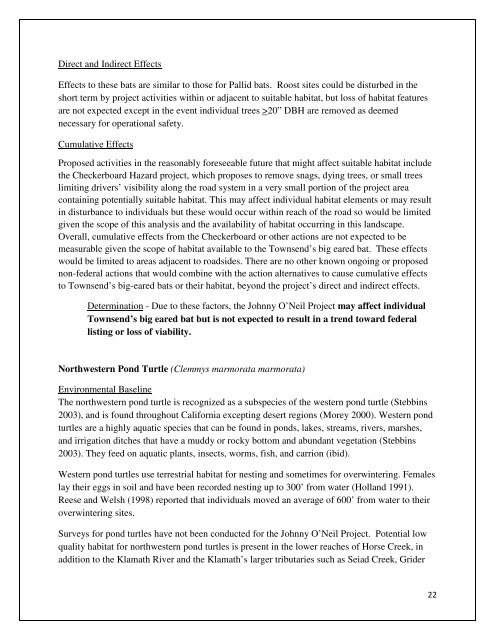Johnny O'Neil Late Successional Reserve Habitat Restoration and ...
Johnny O'Neil Late Successional Reserve Habitat Restoration and ...
Johnny O'Neil Late Successional Reserve Habitat Restoration and ...
Create successful ePaper yourself
Turn your PDF publications into a flip-book with our unique Google optimized e-Paper software.
Direct <strong>and</strong> Indirect Effects<br />
Effects to these bats are similar to those for Pallid bats. Roost sites could be disturbed in the<br />
short term by project activities within or adjacent to suitable habitat, but loss of habitat features<br />
are not expected except in the event individual trees >20” DBH are removed as deemed<br />
necessary for operational safety.<br />
Cumulative Effects<br />
Proposed activities in the reasonably foreseeable future that might affect suitable habitat include<br />
the Checkerboard Hazard project, which proposes to remove snags, dying trees, or small trees<br />
limiting drivers’ visibility along the road system in a very small portion of the project area<br />
containing potentially suitable habitat. This may affect individual habitat elements or may result<br />
in disturbance to individuals but these would occur within reach of the road so would be limited<br />
given the scope of this analysis <strong>and</strong> the availability of habitat occurring in this l<strong>and</strong>scape.<br />
Overall, cumulative effects from the Checkerboard or other actions are not expected to be<br />
measurable given the scope of habitat available to the Townsend’s big eared bat. These effects<br />
would be limited to areas adjacent to roadsides. There are no other known ongoing or proposed<br />
non-federal actions that would combine with the action alternatives to cause cumulative effects<br />
to Townsend’s big-eared bats or their habitat, beyond the project’s direct <strong>and</strong> indirect effects.<br />
Determination - Due to these factors, the <strong>Johnny</strong> O’Neil Project may affect individual<br />
Townsend’s big eared bat but is not expected to result in a trend toward federal<br />
listing or loss of viability.<br />
Northwestern Pond Turtle (Clemmys marmorata marmorata)<br />
Environmental Baseline<br />
The northwestern pond turtle is recognized as a subspecies of the western pond turtle (Stebbins<br />
2003), <strong>and</strong> is found throughout California excepting desert regions (Morey 2000). Western pond<br />
turtles are a highly aquatic species that can be found in ponds, lakes, streams, rivers, marshes,<br />
<strong>and</strong> irrigation ditches that have a muddy or rocky bottom <strong>and</strong> abundant vegetation (Stebbins<br />
2003). They feed on aquatic plants, insects, worms, fish, <strong>and</strong> carrion (ibid).<br />
Western pond turtles use terrestrial habitat for nesting <strong>and</strong> sometimes for overwintering. Females<br />
lay their eggs in soil <strong>and</strong> have been recorded nesting up to 300’ from water (Holl<strong>and</strong> 1991).<br />
Reese <strong>and</strong> Welsh (1998) reported that individuals moved an average of 600’ from water to their<br />
overwintering sites.<br />
Surveys for pond turtles have not been conducted for the <strong>Johnny</strong> O’Neil Project. Potential low<br />
quality habitat for northwestern pond turtles is present in the lower reaches of Horse Creek, in<br />
addition to the Klamath River <strong>and</strong> the Klamath’s larger tributaries such as Seiad Creek, Grider<br />
22
















